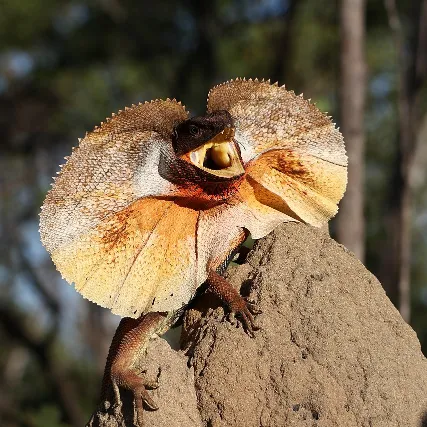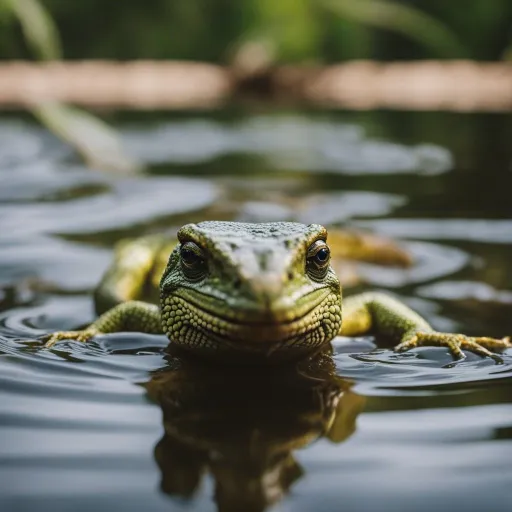So you’ve seen those fascinating frilled lizards with their unique frill necks, and now you’re curious about their diet.
Well, wonder no more! In this article, we’ll uncover the secrets of what these captivating creatures munch on to fuel their frilly adventures.
From insects to small vertebrates, prepare to be amazed by the diverse menu of the frilled lizard.

Frilled Lizards’ Diet
Frilled lizards, scientifically known as Chlamydosaurus kingii, are fascinating reptiles native to the northern regions of Australia and New Guinea.
With their stunning frill that expands around their necks when threatened or during territorial displays, these lizards have captivated the attention of many reptile enthusiasts.
As with any other animal, understanding their diet is crucial to their overall health and well-being.
In this article, we will delve into the diet of frilled lizards, exploring their natural food choices, captive diet options, feeding behavior, hunting techniques, and nutritional requirements.
Overview of Frilled Lizards’ Diet
Frilled lizards are primarily carnivorous creatures, and their diet mainly consists of insects and other invertebrates, small vertebrates, and occasionally fruits and flowers.
In the wild, they have been observed hunting and capturing a wide range of prey to meet their nutritional needs.
However, when kept in captivity, it becomes essential for reptile keepers to provide a balanced and appropriate diet to ensure the health and vitality of these unique reptiles.

Natural Diet
Insects and Other Invertebrates
In the wild, frilled lizards rely heavily on insects and other invertebrates as their primary source of nutrition.
Their diet includes a variety of small insects, such as crickets, grasshoppers, beetles, and spiders.
These agile lizards use their incredible speed and agility to chase and capture their prey. Their long, sticky tongues aid in the quick capture of insects, making them efficient hunters.
Small Vertebrates
Frilled lizards also consume small vertebrates, such as lizards, snakes, small birds, and occasional mammalian prey like mice and rats.
These agile hunters are capable of ambushing their prey, utilizing their remarkable ability to blend in with their surroundings.
The frilled lizard’s predatory instincts come to play as it swiftly strikes and immobilizes the unsuspecting prey with a combination of sharp teeth and strong jaws.
Fruits and Flowers
Although frilled lizards primarily have a carnivorous diet, they have been observed ingesting small amounts of fruits and flowers in the wild.
This behavior is believed to be associated with obtaining additional water and nutrients rather than relying on such food sources for their main nutritional requirements.
Fruits and flowers found in their habitat, such as berries or nectar-producing blooms, may serve as supplementary nutrition for these lizards.
Captive Diet
Commercially Available Diets
In captivity, frilled lizards can be fed a variety of commercially available reptile diets specifically formulated for their nutritional needs.
These commercially prepared diets often come in the form of pelleted or powdered food, enriched with essential vitamins, minerals, and protein sources.
They offer a convenient and balanced alternative to providing live prey.
Live Prey
For those who prefer a more natural approach, live prey can also be offered to frilled lizards in captivity.
This includes a range of insects and small vertebrates that mimic their natural diet, such as crickets, mealworms, roaches, and appropriately sized mice.
Live prey can provide them with mental stimulation and exercise while fulfilling their predatory instincts.
It is crucial, however, to ensure that the prey offered is nutritionally balanced, free from parasites, and of an appropriate size to prevent any harm to the frilled lizard.
Vegetables and Fruits
Supplementing the diet of captive frilled lizards with fresh vegetables and fruits can contribute to their overall nutrition and well-being.
A variety of leafy greens, such as kale, collard greens, and Swiss chard, can be offered alongside small amounts of fruits like berries or diced melons.
It is important to remember that fruits should only be a small portion of their diet, as excessive sugar intake can be detrimental to their health.
Additionally, all food items should be dusted with calcium and vitamin D3 supplements to prevent any nutrient deficiencies.

Seasonal Variations in Diet
Frilled lizards, like many other reptiles, may exhibit seasonal variations in their diet. This variation often corresponds with the availability of prey items specific to each season.
During the mating season, for example, frilled lizards may consume more small vertebrates to provide the necessary energy to reproduce successfully.
Conversely, during periods of scarcity, such as the dry season, their diet may be limited to mainly insects and other readily available invertebrates.
Feeding Behavior
When it comes to feeding, frilled lizards display characteristic behaviors that highlight their unique nature.
These lizards are active foragers, often prowling their habitat in search of prey items. With impressive speed and agility, they use their keen eyesight to locate potential meals.
The frilled lizard’s frill, which is typically nestled against its neck when not expanded, can also serve as a visual cue to intimidate potential prey or predators.
Hunting Techniques and Prey Capture
Frilled lizards employ different hunting techniques depending on the type of prey they are targeting.
For fast-moving insects, they rely on their remarkable speed and agility to give chase and capture their prey swiftly.
In contrast, when hunting small vertebrates, frilled lizards utilize an ambush strategy. They blend seamlessly into their environment, relying on their camouflage to remain undetected by their prey until the opportune moment to strike.
Prey capture often involves a combination of quick movements, sharp teeth, and strong jaws.
Once the prey is within striking distance, the frilled lizard delivers a rapid bite to immobilize it.
It then uses its powerful jaws to apply pressure and prevent its prey from escaping.
This efficient prey capture technique ensures the frilled lizard’s successful consumption of its meal.
Food Digestion and Metabolism
Similar to other reptiles, frilled lizards have a slow metabolic rate. They possess a relatively small digestive system that allows them to process their food slowly, extracting the necessary nutrients efficiently.
It is essential for keepers to provide an appropriate temperature gradient within the lizard’s enclosure to facilitate proper digestion.
Optimal temperatures enable frilled lizards to efficiently break down food, reducing the risk of digestive issues and ensuring the absorption of vital nutrients.
Nutritional Requirements
Frilled lizards have specific nutritional requirements that need to be met to maintain their health and vitality.
Their diet should be rich in essential nutrients, such as proteins, vitamins, and minerals. Calcium, in particular, is crucial for their skeletal health and must be provided through supplementation or through a diet rich in calcium-rich prey items.
Vitamin D3 is also necessary for proper calcium absorption, and adequate exposure to UVB lighting is important for their overall well-being.
Feeding Frequency and Portion Sizes
Feeding frequency and portion sizes for frilled lizards can vary depending on their age, size, and individual metabolism.
Juvenile frilled lizards may require more frequent feedings, typically every 1-2 days, to support their rapid growth.
Adult frilled lizards, on the other hand, can be fed less frequently, around 2-3 times a week.
It is important to monitor their weight and adjust the portion sizes accordingly to prevent overfeeding or underfeeding.
Final Thoughts
In conclusion, frilled lizards have a diverse diet that is primarily carnivorous, consisting of insects, small vertebrates, and occasionally fruits and flowers.
In captivity, they can be fed a balanced diet using commercially available reptile diets, supplemented with live prey and fresh vegetables and fruits.
Understanding their seasonal variations, feeding behavior, hunting techniques, and nutritional requirements is essential for providing optimal care and ensuring the well-being of these remarkable reptiles.



